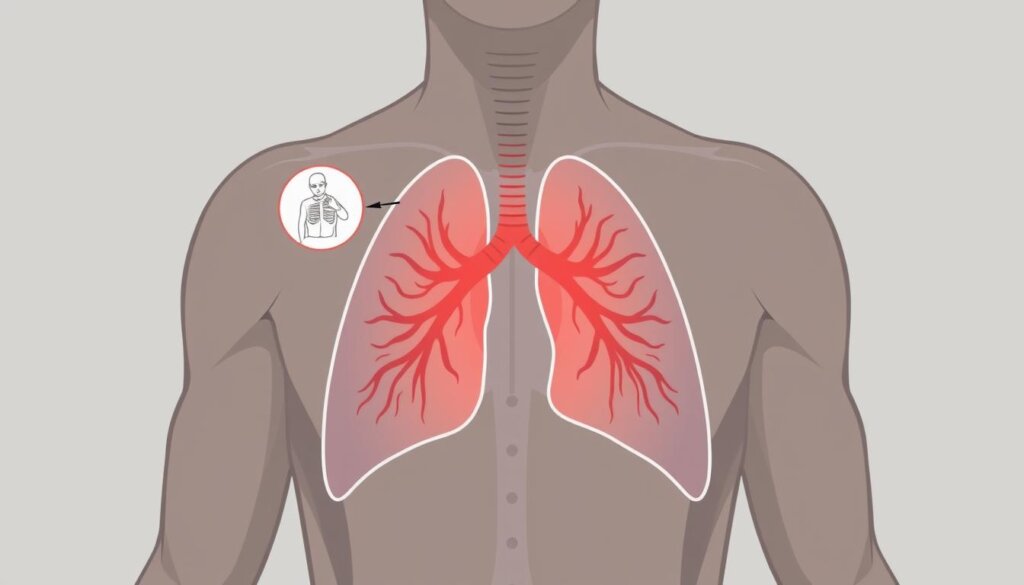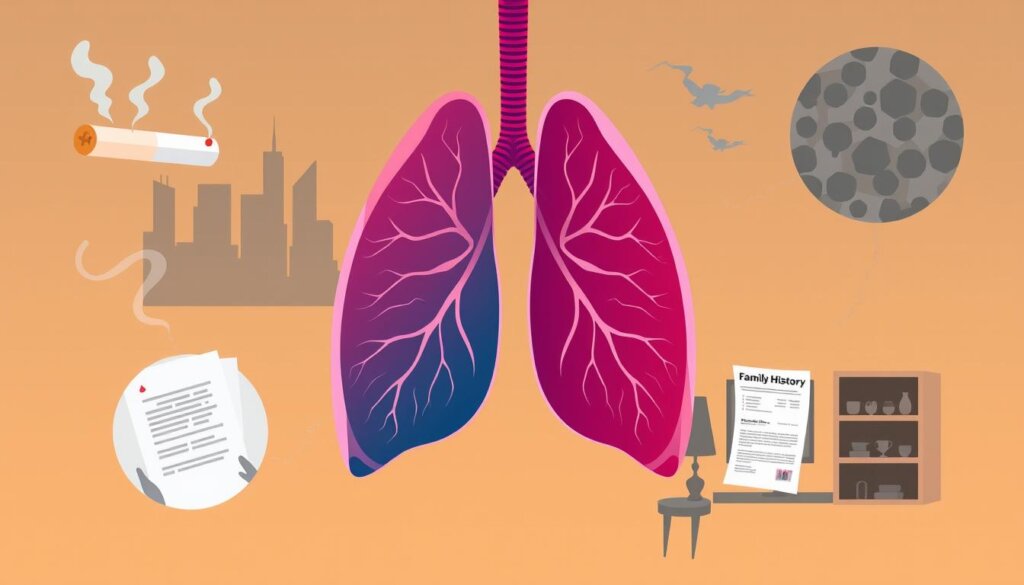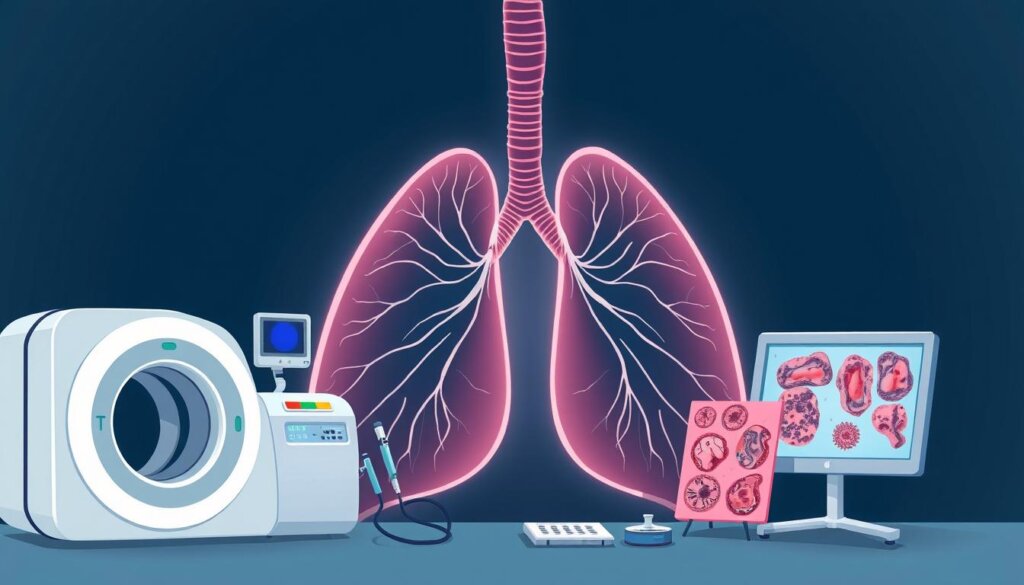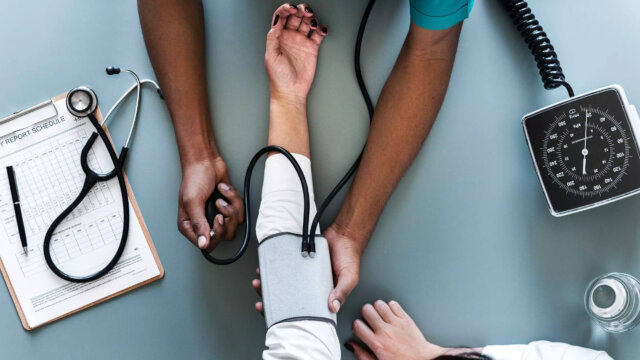FTC disclaimer: This post may contains affiliate links and we will be compensated if you click on a link and make a purchase.
Lung cancer is the top cause of cancer deaths worldwide. It takes many lives every year. This fact shows how important it is to know about bronchogenic carcinoma, which includes all lung cancers. It has two main types: small cell lung cancer (SCLC) and non-small cell lung cancer (NSCLC). These types are a big threat to our health.
Bronchogenic carcinoma, or lung cancer, is a serious disease. It needs a deep understanding and good care. Learning about its symptoms, causes, diagnosis, and treatments helps you make smart choices. This way, you can improve your lung health.
Key Takeaways
- Lung cancer is the leading cause of cancer deaths worldwide, with smoking being the primary cause.
- Bronchogenic carcinoma encompasses two main types: small cell lung cancer (SCLC) and non-small cell lung cancer (NSCLC).
- Various factors, including secondhand smoke, workplace exposure, and genetic predisposition can cause lung cancer.
- Early detection through screening and diagnostic tests is crucial for effective treatment and improved outcomes.
- Treatment options for bronchogenic carcinoma include surgery, radiation therapy, chemotherapy, targeted therapies, and immunotherapy.
What is Bronchogenic Carcinoma?
Definition and Types
Bronchogenic carcinoma is a term for any lung cancer. It includes small cell lung cancer (SCLC) and non-small cell lung cancer (NSCLC). NSCLC makes up about 80% of lung cancer cases.
NSCLC has three main types: adenocarcinoma, squamous cell carcinoma, and large cell carcinoma. Adenocarcinoma is the most common, making up 30% of lung cancer cases.
SCLC is less common, making up 10% to 15% of lung cancers. It is often caused by heavy smoking. Other rare types, like carcinoid tumors, make up less than 5% of lung tumors.

Pancoast tumors are a rare type of lung cancer. Lung carcinoid tumors grow slowly and makeup 1-2% of lung cancer cases.
“Bronchogenic carcinoma is any type or subtype of lung cancer. The term was once used to describe only certain lung cancers that began in the bronchi and bronchioles, the passageways to the lungs. However, today it refers to any type.”
Symptoms of Bronchogenic Carcinoma
Bronchogenic carcinoma, also known as lung cancer, shows different symptoms at different stages. Early signs are often mild and easy to miss until the cancer grows.
A common early symptom is a cough that doesn’t disappear or worsen. It might bring up blood or mucus. Other early signs include wheezing, chest pain, and shortness of breath.
As the disease gets worse, people might feel hoarseness, weakness, and keep getting bronchitis or pneumonia.
When lung cancer spreads, new symptoms can appear. These include hip or back pain, headaches, dizziness, and seizures. People might also feel numbness in their limbs, have jaundice, swollen lymph nodes, and lose weight without trying.
Some lung cancers don’t show symptoms until they’re very advanced. Finding lung cancer early is key for better treatment and outcomes. If you notice any strange or lasting symptoms, see a doctor right away.

Early Symptoms | Advanced Symptoms |
|---|---|
|
|
In summary, bronchogenic carcinoma symptoms can be mild or severe. Spotting them early is key for quick diagnosis and treatment.
Causes and Risk Factors
Lung cancer, including bronchogenic carcinoma, has many causes. While we don’t know everything, we know some big risk factors. These can make you more likely to get this serious cancer.
Smoking and Lung Cancer
Smoking is the main cause of bronchogenic carcinoma. It leads to about 80% of lung cancer deaths in the U.S.. Quitting smoking greatly lowers your risk. Also, avoiding secondhand smoke is key.
About 90 percent of lung cancers come from cigarette smoking. If we stopped smoking, 90 percent of lung cancer cases could be prevented.
Radon Exposure and Lung Cancer
Radon is the second biggest cause of lung cancer in the U.S. It’s a radioactive gas that can get into buildings. Radon exposure is linked to 30 percent of lung cancer deaths in non-smokers.
Other Risk Factors
Other things can also raise your risk of lung cancer:
- Being around harmful chemicals like asbestos, arsenic, and some petroleum products. People who work with asbestos are at much higher risk.
- Having had radiation therapy to the chest. This increases your risk, especially if you smoke.
- Having a family history of lung cancer. If you have a family member with lung cancer, you’re twice as likely to get it. This risk is even higher if you have two or more first-degree relatives with lung cancer.
- Being exposed to outdoor air pollution. It causes about 1% to 2% of lung cancer deaths in the U.S..
- Smoking marijuana. It may raise your risk of lung cancer because of tar and harmful substances like tobacco smoke.
- Using e-cigarettes. They haven’t been proven to lower lung cancer risk and may harm your lungs, says the FDA.
Lung cancer is more common in men, especially African American men, than in women.

Knowing the causes of bronchogenic carcinoma and lung cancer risk factors helps you make healthy choices. It’s important to take steps to lower your risk of getting this serious disease.
Diagnosis of Bronchogenic Carcinoma
Diagnosing bronchogenic carcinoma, a lung cancer type, needs a full check-up. This includes looking at your symptoms and medical history and doing tests. Lung cancer kills more women than breast cancer since 1987. About 225,000 new cases are found each year in the U.S..
If you’re over 55, smoked a lot, or have a family history, your doctor might suggest a screening. These tests often start with chest X-rays. Low-dose CT scans are used yearly for those 50 and older who smoked a lot or quit recently.
More tests might include sputum cytology and biopsies to get tissue samples. A bronchoscopy, with a tube and camera, is used to take tissue for lab tests.
The pathologist will tell you the type and stage if cancer is found. Staging tests like biopsies, CT, MRI, PET, and bone scans help see how far it has spread.
Getting the right diagnosis and stage is key to treatment. Working with your healthcare team helps manage your cancer and maintain your quality of life.

Treatment Options for Bronchogenic Carcinoma
If you have bronchogenic carcinoma, also known as lung cancer, your treatment will depend on several things. These include the type and stage of your cancer, and your overall health. There are many treatment options, each with its own benefits and things to consider.
For early-stage non-small cell lung cancer (NSCLC), surgery might be the main treatment. Stage 0 NSCLC can often be cured with surgery alone, without needing chemotherapy or radiation. For stage I NSCLC, surgery might be enough, but sometimes chemotherapy, immunotherapy, or targeted therapy are added to lower the chance of cancer coming back.
In more advanced stages of NSCLC, a mix of treatments might be needed. For stage II NSCLC, chemotherapy with or without immunotherapy is often given before surgery. Stage IIIA NSCLC treatment can include radiation therapy, chemotherapy, immunotherapy, and/or surgery, based on the tumor’s size and location. Stage IIIB NSCLC treatment often includes chemoradiation therapy, immunotherapy, and possibly surgery if the cancer is not in a place that can be easily operated on.
For stage IV NSCLC, treatments vary based on how far the cancer has spread. Options include surgery, chemotherapy, targeted therapy, immunotherapy, and palliative procedures. Genetic testing is key to find the right targeted therapies for stage IV lung cancer. The levels of the PD-L1 protein are also checked to see if immune checkpoint inhibitors will work.
In advanced lung cancer, local treatments like laser therapy, photodynamic therapy (PDT), or stent placement can help relieve symptoms caused by lung tumors.
It’s important to know that treatment for bronchogenic carcinoma isn’t just what’s mentioned. Clinical trials are available to test new treatments. Also, complementary and alternative medicine practices, such as acupuncture and supplements, can be used along with standard cancer therapies.
Working closely with your healthcare team is key to finding the best treatment plan for you. Being open and active in your care can help you get the best results.
Prevention Strategies
Stopping bronchogenic carcinoma, a lung cancer type, is key to staying healthy. The main way to prevent lung cancer is to tackle the main risk factors. Quitting smoking is the most important step, as it causes up to 90% of lung cancer in men and 80% in women. Smokers are 20 times more likely to get lung cancer than non-smokers.
Radon is another big risk. Testing your home for radon and fixing high levels can lower your risk. Also, avoiding harmful substances like asbestos, arsenic, and chromium at work can help prevent bronchogenic carcinoma.
Living a healthy life, eating well, and exercising can also help prevent lung cancer. But, taking too many vitamins can actually increase cancer risk in some people.
Even though most lung cancers can be prevented, some cases have no clear cause. Still, by reducing your risk factors, you can lower your chance of getting bronchogenic carcinoma.
Reducing Risk Factors
- Quit smoking and avoid secondhand smoke exposure.
- Test your home for radon and mitigate high levels.
- Limit exposure to occupational carcinogens like asbestos, arsenic, and chromium.
- Maintain a healthy diet rich in fruits and vegetables.
- Engage in regular physical activity.
- Avoid high-dose vitamin supplements, as they may increase cancer risk in some populations.
Risk Factor | Increased Risk |
|---|---|
Smoking | 20 times higher risk compared to non-smokers |
Family History | Twice the risk of developing lung cancer |
HIV Infection | More than double the risk of lung cancer |
Occupational Exposure | More than 5-fold increase in incidence and mortality |
Radon Exposure | Significant cause of lung cancer |
Secondhand Smoke | Approximately 20% increased risk for non-smokers |
Outdoor Air Pollution | Approximately 40% increased risk in highest exposure categories |
“Lung cancer risk is more common in men than women and in those of lower socioeconomic status. African American men have a very high rate of lung cancer, not entirely explained by historical smoking patterns.”
By tackling these risk factors, you can greatly reduce your chance of getting bronchogenic carcinoma. This helps you stay safe from lung cancer for the long term.
Prognosis and Outlook
The outlook for bronchogenic carcinoma, or lung cancer, depends on many things. These include the cancer type, its stage, and the patient’s health. The Surveillance, Epidemiology, and End Results (SEER) give us 5-year survival rates for lung cancer types.
For NSCLC, survival rates are 65% for early cancer, 37% for cancer that has spread, and 9% for cancer that has spread far. SCLC survival rates are 30% for early cancer, 18% for cancer that has spread, and 3% for far-spreading cancer.
These numbers are averages, and each person’s case is different. Age, gender, health, and genetic changes in cancer cells can affect survival chances.
Early detection and quick, right treatment are key to better outcomes in bronchogenic carcinoma. Those caught early and treated right have a better chance than those with advanced disease.
New research and treatments like targeted and immunotherapies are helping more people survive lung cancer.
The prognosis and outlook for bronchogenic carcinoma are complex. Patients should talk to their doctors to understand their chances and make a care plan.
Living with Bronchogenic Carcinoma
Coping and Support
Getting a diagnosis of bronchogenic carcinoma can feel scary. But, there are ways to help you cope. Working with lung cancer doctors is key to knowing your treatment options. Joining a lung cancer support group can connect you with others facing the same thing. It offers emotional support and valuable info.
Palliative care can also improve quality of life. Studies show that 26% of patients live for 5 years or more after surgery. For adenocarcinoma, the survival rate is 34% for 5 years and 21% for 10 years.
Dealing with lung cancer is tough, but there’s help. You can face the challenges by working with doctors and joining support groups. It helps with both the physical and emotional sides of living with bronchogenic carcinoma.
Lung Cancer Survival Rates | 5-Year Survival | 10-Year Survival |
|---|---|---|
Surgical Resection | 26% | 18% |
Adenocarcinoma | 34% | 21% |
Bronchioloalveolar Carcinoma | 41% | N/A |
Undifferentiated Large Cell Carcinoma | N/A | 14% |
Adenosquamous Carcinoma | N/A | 8.3% |
“Joining a lung cancer support group, either in-person or online, can connect patients with others going through similar experiences and provide valuable information and emotional support.”
Support groups are not the only help. Lung cancer support organizations offer resources and counseling, helping patients and families cope with the challenges of this disease.
Latest Research and Developments
The study of bronchogenic carcinoma is moving fast. Scientists and doctors are making big steps in fighting this deadly lung cancer. The NCI-sponsored National Lung Screening Trial (NLST) found that low-dose CT scans help in early detection for heavy smokers. They also made computer programs that can spot lung cancer with 97% accuracy and find cancer-causing mutations.
New treatments are coming too. Targeted and immunotherapies are being tested and approved for bronchogenic carcinoma. Osimertinib (Tagrisso) was approved in 2021 for early-stage NSCLC with certain EGFR gene mutations. Drugs like atezolizumab (Tecentriq), pembrolizumab (Keytruda), and nivolumab (Opdivo) are showing better results in early-stage NSCLC.
Researchers are looking into new ways to fight bronchogenic carcinoma. Immunotherapies, like JAK Inhibitors with pembrolizumab (Keytruda) and atezolizumab (Tecentriq), are shrinking tumors in patients and animals. Targeted therapies for specific genetic changes in NSCLC are also showing promise.
The study of bronchogenic carcinoma is always changing. Scientists are working on early detection, personalized treatments, and better patient care. A group of 140 genes may help predict better outcomes in NSCLC patients with immunotherapy. Monitoring ctDNA can also show how well immunotherapies are working for metastatic NSCLC.
Despite progress, there’s still a lot to do against bronchogenic carcinoma. Treatment improvements have led to fewer deaths from lung cancer. Lung cancer screening via chest low-dose CT is 89% sensitive and 79% specific. But, the false positive rate in the Providence VA program was 13.5%, with a 2% invasive procedure rate.
As scientists learn more about bronchogenic carcinoma, patients and doctors will see more progress. This includes better early detection, targeted therapies, and treatments tailored to each patient. These advancements will help improve outcomes for those with this devastating disease.
Conclusion
Bronchogenic carcinoma, or lung cancer, is a serious disease. But, there is hope. By knowing the symptoms, risk factors, and treatments, you can work with doctors to find the best care plan.
Quitting smoking and avoiding harmful substances are key to preventing lung cancer. Getting screenings is also important. Lung cancer is often deadly, but research and new treatments are helping more people survive.
Early detection and the right care can greatly improve your chances of beating lung cancer. This is a hopeful time for those fighting this disease.
Understanding bronchogenic carcinoma is crucial. We need better screening and early detection, and new treatments are giving patients and their families more hope.
By staying informed and taking action, you can help fight lung cancer. Your efforts are vital in this battle.
Bronchogenic carcinoma requires a team effort to tackle. With the right knowledge and care, the outlook for lung cancer patients is improving. By being proactive and caring for your health, you can manage this disease and improve your life.
FAQ
What is bronchogenic carcinoma?
Bronchogenic carcinoma is another name for lung cancer. It includes two main types: small cell lung cancer (SCLC) and non-small cell lung cancer (NSCLC).
What are the symptoms of bronchogenic carcinoma?
Early signs include a long-lasting cough and wheezing. You might also cough up blood or feel chest pain. Shortness of breath and hoarseness are common too.
Advanced symptoms can be hip or back pain. You might also feel dizzy, have seizures, or numbness. Jaundice, swollen lymph nodes, and unexplained weight loss are signs too.
What causes bronchogenic carcinoma?
Smoking is the main cause, leading to about 90% of lung cancer cases. Radon, harmful chemicals, air pollution, and family history also play a role.
How is bronchogenic carcinoma diagnosed?
Doctors use chest X-rays and CT scans to start. They might also do sputum cytology and biopsies to get tissue samples. To see how far the cancer has spread, they use more tests like MRI and PET scans.
What are the treatment options for bronchogenic carcinoma?
Treatments include surgery, chemotherapy, and radiation therapy. Targeted drug therapy and immunotherapy are options too. The right treatment depends on the cancer type, stage, and the patient’s health.
How can bronchogenic carcinoma be prevented?
The best way to prevent it is to avoid smoking and secondhand smoke. Test your home for radon and avoid harmful chemicals at work and in the environment.
What is the prognosis for bronchogenic carcinoma?
The outlook depends on the cancer type, stage, and the patient’s age and health. Early detection and the right treatment are key to better outcomes.
What support is available for those living with bronchogenic carcinoma?
You can work with lung cancer specialists and join support groups. Palliative care helps manage symptoms and side effects.
What are the latest developments in bronchogenic carcinoma research?
Research is improving targeted therapies and immunotherapies. There are also advances in early detection and surgical and radiation techniques. These aim to help lung cancer patients more.








